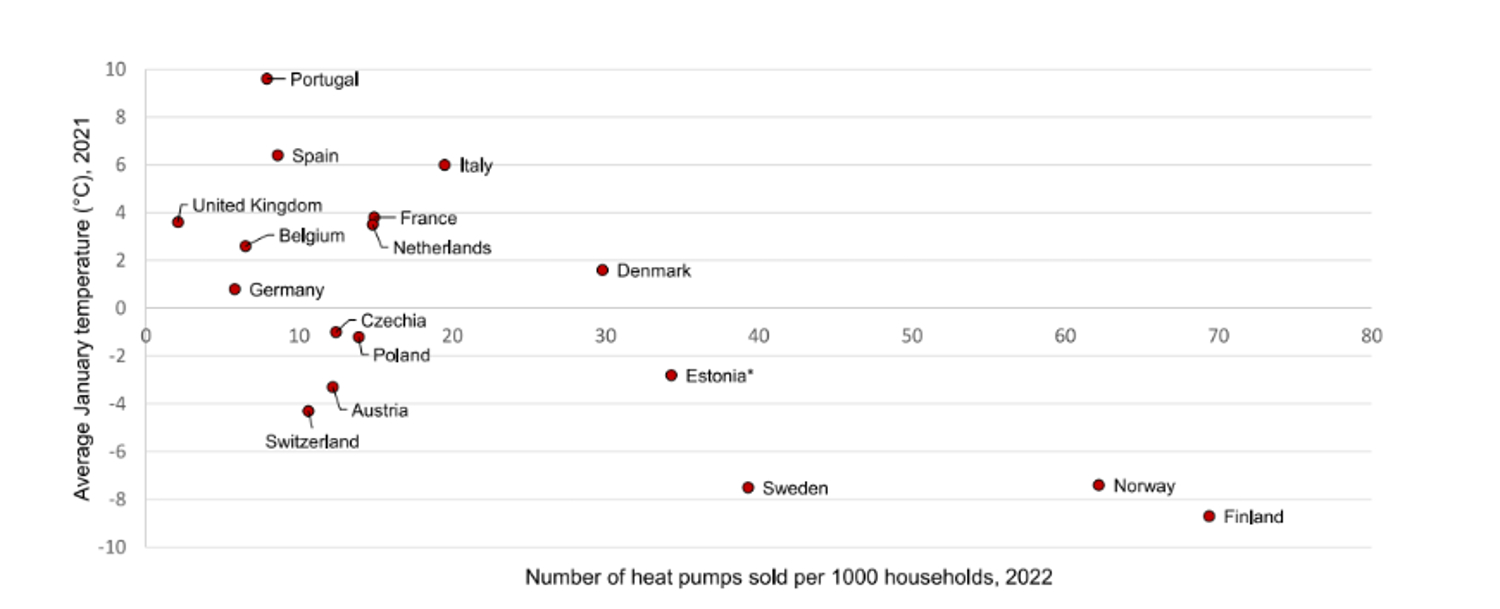
A new study from Oxford University and the Regulatory Assistance Project used data from seven field studies across North America, Asia, and Europe which shows that heat pumps are two to three times as efficient as combustion or resistive electric heating technology, even in temperatures well below 0°C (32º F). In fact they perform significantly better than their fossil fuel-based competitors even in temperatures approaching -30°C (-22º F).
Heat Pumps In Maine
These findings suggest standard heat pumps are suitable for almost all American homes, which will come as no surprise to people in Maine who have switched to them in a big way in response to a program of education about heat pumps coupled with significant rebates provided by the state government. The changeover to the newer technology has fossil fuel interests concerned.
According to the Washington Post, the National Oilheat Research Alliance, a trade association representing heating oil sellers, has funded campaigns fighting electrification that target New England homeowners and real estate agents. The alliance’s propane counterpart, the Propane Education and Research Council, has put out training material coaching installers how to dissuade customers from switching to electrical appliances.
“The ‘electrify everything’ movement is moving forward across the Northeast and in other parts of the country with a vengeance,” Richard Carrione, a consultant paid by the National Oilheat Research Alliance, wrote last fall in an industry magazine. “It will be incumbent on our industry to educate and activate Mainers about the pitfalls of electrification,” he wrote. “The battle has just begun. Stay tuned.”
Baby, It’s Cold Outside
For years, the knock on heat pumps was that they could not provide reliable heat for residential customers once the temperature outside dropped below 20º F (-7º C). In fact, that used to be true a decade ago, but advances in technology since then have resulted in a new generation of heat pumps that can provide reliable heat even in the coldest temperatures.
The research showed that even when it was bitter cold out, those next generation heat pumps were still 1.5 times more efficient that traditional heat sources. The findings were published in the journal Joule on September 11, 2023.
Air source heat pumps typically use electricity to drive a refrigeration cycle that moves heat from a colder source to a warmer destination. One important aspect of measuring the performance of a heat pump is its efficiency, which is measured by the coefficient of performance — the ratio of the useful heat produced to energy consumed.
Typical performance values for heat pumps range from 3 to 6, which indicates that 3 to 6 units of heat are created from each unit of electricity used. A year-round average of 3 to 4 is common for household applications. European winters with average January temperatures above 10º C are classified as “mild cold climates,” whereas those with average temperatures below 10º C in the coldest month are designated “extreme cold climates.” The studies analyzed for this commentary reveal two key findings:
- Standard air source heat pumps can maintain average efficiency ratings between 2 and 3 in mild cold climates
- Cold climate air source heat pumps can see efficiency ratings above 1.5 in extreme low temperatures
Do You Need Back-Up Heating?
One way to make heat pumps more efficient in cold temperatures is to use ground source technology. Air source equipment needs to use some of the available energy to defrost their components when the temperatures turn frigid. Ground source machines do not require such defrosting as the temperature of the Earth remains fairly constant regardless of ambient air temperature. However, installation is more complex and therefore more expensive.
The question whether back-up heating is needed for extreme conditions often comes up. Several of the studies included in this research — including data from Switzerland, Germany, the US, the UK, Canada, and China — included the use of back-up heating, or at least the availability of it if needed. However, back-up heating was typically only engaged when the outside temperature dropped below 10º C. Above that, heat pumps were able to provide the required heat at relatively high efficiency.
The researchers say concerns over the need for back-up heating during mild cold climate conditions may be unfounded and the role for hybrid systems may be limited. There remains a question over the role of hybrid systems in the coldest climates, not necessarily because of efficiency performance but because of the high output capacity of heat pumps needed at very low temperatures.
To address these concerns, they recommend efforts to improve the thermal efficiency of homes and commercial structures to minimize loads and level off heating demand peaks, as well as encouraging demand response.
Choose The Right Equipment
The researchers point out that heat pumps are not a “one size fits all” proposition. Different models are specified for different temperature zones. They advise that some heat pumps are specifically designed for extreme cold. Although installing cold climate heat pumps may de-risk performance in the coldest weather, there are potential trade-offs.
Performance may suffer during milder temperatures because cold climate systems are designed specifically for frigid temperatures and higher heating demands. Physical components such as the expansion valve and compressor may struggle to operate properly at lower outputs. The best advice for those interested in installing a heat pump to replace an existing combustion or resistive heating system is to seek the advice of a qualified installer in order to get the correct equipment for a particular application.

Image cource: Joule
One of the interesting bits of information to come out of the study is the percentage of homes using heat pump technology in places where winter is most tenacious. In general, the colder the winter and the higher the cost of heating fuels, the more of them are being installed. That seems to answer any concerns about using heat pumps in places where winter is tenacious.
Experts Weigh In On Heat Pumps
Yannick Monschauer, an energy analyst at the International Energy Agency, said in an email to CleanTechnica, “Thanks to continuous efforts on research and development — including by collaborators within the IEA’s Technology Collaboration Program — manufacturers have developed specialized heat pumps that work very efficiently in cold climates. Worldwide, the share of heat pumps in heating equipment sales is set to more than double by 2030 under today’s policies, as deployment also accelerates in colder climates.”
Jan Rosenow, director of European programs for the Regulatory Assistance Project added, “Last year, more heat pumps were sold than natural gas furnaces in the U.S. for the first time. The generous incentives in the Inflation Reduction Act will help continue this trend but even more sales are needed to meet the American climate targets. This new research features data from the United States and shows that heat pumps can perform very well, even in the coldest parts of the country.
Paul Lambert, founder and CEO at Quilt, a heat pump startup based in the San Francisco Bay Area, added one more reason for making the switch to heat pumps. They “provide a new level of comfort even at the coldest temperatures — including the comfort that you are leaving fossil fuels behind.”
I don’t like paywalls. You don’t like paywalls. Who likes paywalls? Here at CleanTechnica, we implemented a limited paywall for a while, but it always felt wrong — and it was always tough to decide what we should put behind there. In theory, your most exclusive and best content goes behind a paywall. But then fewer people read it! We just don’t like paywalls, and so we’ve decided to ditch ours. Unfortunately, the media business is still a tough, cut-throat business with tiny margins. It’s a never-ending Olympic challenge to stay above water or even perhaps — gasp — grow. So …


